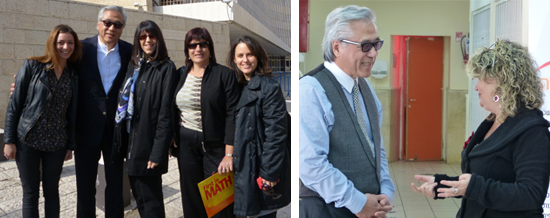by Robert Sun
EASTON, PA—Recently, I had an unexpected insight about mathematics. During a visit to an Israeli classroom where English was being taught as a second language, I observed a group of fourth-graders learning the 20 words assigned for that day. I saw how essential social interaction is when learning a language, and it reminded me of my own experience as a nine-year old struggling to learn English in my newly-adopted country.

Left: Rachel Gentely, Development Team Coordinator, Israel; Robert Sun; Suntex Executive Vice President Nan Ronis; Shoshi Nisan, Pedagogical Coordinator, Kadima Mada and Rebecca Levy, Project Writer. Right: Sun speaks with Tzila Levi Sneer, Education Director, Nazareth Illit Municipality.
Learning math is typically a much easier endeavor. With math, we are spared the years of effort needed to acquire an extensive vocabulary. You don’t have to know what each number means, only how it relates to other numbers and to how numbers connect.
One reason math is challenging for so many young people is because it is so rarely spoken. Math instruction traditionally focuses on the written component—textbooks, board work and worksheets. Contrast this to learning English. Although there is a written component—grammar, composition, reading—there is also constant interaction, feedback and encouragement from others through conversation.
I would like to see our education system place the same emphasis on achieving fluency in math as it does on language. I believe that as educators and as a society, we need to develop the idea of ‘social math’ – the use of spoken math to inspire the human interactions that provide the feedback and motivation to master fluency.
Encouraging children, from a very early age, to speak as well as write the language of mathematics, is one way we can begin to develop social math. Teachers can encourage their students to express themselves verbally using mathematical terms; even in early grades, children can be asked to explain what they want or mean using numbers or relationships between numbers. Anything that encourages them to talk about math and mathematical concepts is beneficial.
Many educators who are using First In Math in their classroom have integrated social math into their teaching. Using a whiteboard and engaging the class as a group to solve problems by explaining their thought process to each other is an effective way to encourage speaking math.
Now that I’ve gotten you thinking about the concept of social math, begin to take notice of how often you speak math throughout your day. How often do others use mathematical terms or language when they are communicating with you? Teachers—do you speak math with your students in the classroom? We are interested in learning more about your social math experiences. Please share your best practices for speaking math with us at deborah@firstinmath.com
Learn more about Robert Sun’s thoughts regarding social math and how to support our next generation in achieving math mastery and fluency here. Follow Bob on twitter @RobertSun24